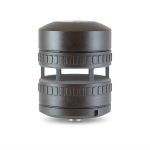A new GNSS/INS receiver, the AsteRx-i D UAS from Septentrio, specifically targets integration into unmanned aerial systems (UAS). It provides centimeter-level RTK positioning and 3D attitude. It features a 44 pin connector compatible with 3rd-party integrations, as well as event marker inputs to accurately time-stamp camera shutter events.
The multi-frequency receiver’s positioning and 3D heading, pitch and roll orientation capabilities enable automated navigation of aerial drones and robots. With a high-performance inertial measurement unit (IMU) from Analog Devices integrated directly into the board, it is compact and lightweight. Aboard a drone, its small form-factor combined with low power consumption op[roduces extended battery life and longer flight times.
AsteRx-i D UAS is the first commercial product from Septentrio’s collaboration with Analog Devices, designed for demanding industrial environments. Both single-antenna and dual-antenna versions are available, with the latter suited for machines that need reliable heading directly from the start.
The receiver carries Advanced Interference Mitigation (AIM+) technology. In aerial drones, where many electronics are crammed into a small space, neighboring devices can emit electromagnetic radiation, interfering with GNSS signals. AIM+ offers protection against such interference, producing faster set-up times and robust continuous operation. The on-board IMU is robust against mechanical vibrations; combined with Septentrio’s anti-shock LOCK+ technology, it is resilient against impact during takeoff and landing.
The receiver’s APME+ functionality effectively disentangles direct and reflected signals produced by metal and large nearby structures. APME+ is bias free and can be disabled. Advanced Receiver Autonomous Integrity Monitoring (RAIM+) comprises fault detection mechanisms of the receiver at all levels including the generation of measurements, quality control and navigation algorithms. Detected faulty measurements, typically caused by high multipath or active ionosphere, are removed from the solution.
Consuming typically 2 W with a total weight of under 60 g, it conforms to requirements for minimal space and payload. The 4.5-30 V input power range allows powering the receiver directly from the UAS power bus. The IMU is soldered directly onto the board, removing the need for connectors and bolts, reducing the effective weight and size of the receiver.
The AsteRx-i D UAS supports tracking of the following signals:
• GPS: L1, L2
• GLONASS: L1, L2
• Galileo1 : E1, E5b
• BeiDou1 : B1, B2
• SBAS: EGNOS, WAAS, GAGAN, MSAS, SDCM (L1)
• QZSS: L1, L2
Integrated position accuracy
Standalone: Horizontal 1.2 m; Vertical 1.9 m
SBAS: Horizontal 0.6 m; Vertical 0.8 m
DGPS: Horizontal 0.4 m; Vertical 0.7 m
RTK-INS
Horizontal accuracy 0.6 cm + 0.5 ppm
Vertical accuracy 1 cm + 1 ppm
Initialization 7 s
Photo courtesy Septentrio.






